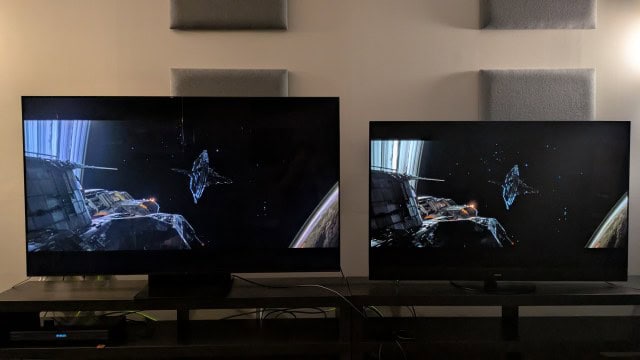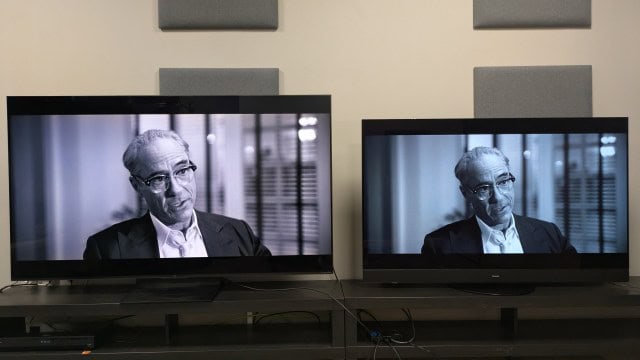I compared mid-range mini-LED and OLED TVs, and while it’s closer than you might think, OLED wins in one vital area
OLED and mini-LED are the two leading display technologies, with both offering improved picture quality over standard LED TVs.
Most of the best TVs use these two technologies, but deciding which one is more suitable for you can depend on several factors. Previously, OLED was the go-to option for better black levels and contrast, while Mini-LED was better for brightness. While this remains partially the case, the differences between what each panel tech can offer have changed somewhat.
Some of the best OLED TVs, such as the LG G5, are now hitting over 2,000 nits peak brightness, which is enough to compete with mini-LED TVs. And some of the best mini-LED TVs now have significantly improved local dimming, allowing for deeper and more OLED-like blacks.
I’ve been testing the TCL C7K mini-LED TV, the mid-range model in TCL’s 2025 UK TV lineup, and decided to put it up against our reference Panasonic MZ1500 OLED TV (from 2023) to see how much the gap between the two technologies has been closed.
A quick note: these two TVs are only available in the UK, but for our US readers, the closest equivalents would be the TCL QM7K mini-LED and either the Panasonic Z85A OLED from 2024 or the LG C5 OLED from 2025.
OLED vs mini-LED: color
Image 1 of 2


Both OLED and mini-LED have their advantages when it comes to color. With Mini-LED TVs, colors tend to be brighter and punchier, while colors on OLED TVs tend to look more saturated and have greater depth due to OLED tech’s inherently high contrast. However, this wasn’t completely the case with the C7K and MZ1500.
Watching a 4K Blu-ray of Wicked with both TVs in their Dolby Vision Dark picture mode, the TCL C7K’s colors had a surprising amount of depth while still showcasing the punch mini-LED TVs get from their high peak brightness. The pink flowers around Elphaba during the ‘Wizard & I’ scene looked vibrant on both TVs, but I couldn’t help but be more drawn to the C7K.
The MZ1500 still showed the advantages of OLED’s self-emitting pixels vs the C7K’s local dimming backlight, with Elphaba’s green skin and the blue details in a design on the wall revealing better contrast, but the C7K was no slouch here.
It was also no slouch when viewing demo footage in HDR10 format on the Spears & Munsil UHD Benchmark 4K Blu-ray. With both TVs set to Filmmaker Mode, the yellows and greens in a butterfly’s wings were brighter and seemed more natural as compared to the MZ1500’s bolder, deeper display.
OLED vs mini-LED: black levels, contrast, and detail
Image 1 of 2


One area where the C7K impressed in my comparison was black levels. Throughout Alien: Romulus, in any scene in a dark hallway or tunnel, the C7K’s black levels looked deeper and richer than I’d anticipated. Yes, the MZ1500 was better here, but it was still an excellent demonstration of the C7K’s local dimming prowess.
The same was true when watching The Batman. Shadow detail on both TVs was excellent in the opening crime scene sequence, and the C7K showed vastly improved black levels compared to some mini-LEDs I’d tested in the past.
Contrast was another area where competition was closer than expected. The C7K displayed a great balance between light and dark tones in the bright lights punctuating gloomy surroundings in both Alien: Romulus and The Batman, holding itself up well against the MZ1500.
As with color, the MZ1500 OLED gave textures greater perceived depth and detail, creating a more 3D-like quality. But the same textures, such as skin and facial features, were displayed with a lifelike quality on the C7K as well.
OLED vs mini-LED: screen uniformity
Image 1 of 2


The C7K had impressed me during my comparison so far, but there’s one area where the Panasonic OLED triumphed: screen uniformity.
Screen uniformity refers to a TV’s ability to evenly display large areas of the same color, such as black. OLED panels use self-emitting pixels instead of a backlight and, as a result, they can deliver uniform tones across all areas of the screen. But as mini-LED TVs use backlights to produce light, insufficient control of backlight local dimming zones can create uniformity issues.
Watching black and white scenes from Oppenheimer, the C7K did a great job of accurately displaying black and white tones, along with a good range of grays, but I also noticed streaks of brown underneath the black letterbox bars in these widescreen scenes – a sign of sub-par screen uniformity. This wasn’t an issue on the MZ1500 OLED.
OLED vs mini-LED: conclusion

Ultimately, the MZ1500 OLED had the superior picture in my comparison, thanks to its self-emitting pixels. But, there’s a key thing to remember here: price.
For a 65-inch C7K at launch, you’d be paying £1,399 ($1,499 for the QM7K in the US, and roughly AU$2,326) whereas the MZ1500 65-inch at launch in 2023 was £2,900 (roughly $3,700 / AU$5,400).
Panasonic’s OLEDs are notoriously pricey, but even a new mid-range OLED such as the LG C5 costs $2,699.99 / £2,699.99 / AU$4,299. That is one heck of a price gap.
So yes, while the MZ1500 does come out on top, the C7K (and the QM7K, which earned four and a half out of five stars in our review) demonstrates the solid level of performance you can now expect from a mini-LED TV, along with its comparatively high value when pitted against an OLED TV.
You might also like
OLED and mini-LED are the two leading display technologies, with both offering improved picture quality over standard LED TVs. Most of the best TVs use these two technologies, but deciding which one is more suitable for you can depend on several factors. Previously, OLED was the go-to option for better…
Recent Posts
- Breville Oracle Jet Review (2025): Easy and Delicious
- I compared mid-range mini-LED and OLED TVs, and while it’s closer than you might think, OLED wins in one vital area
- Google’s Veo 3 AI video generator is a slop monger’s dream
- I review motorbikes for a living – here’s why I’m excited about GoPro’s new smart motorcycle helmet
- 15 Best Memorial Day Tech Deals (2025): iPads and Bluetooth Speakers
Archives
- May 2025
- April 2025
- March 2025
- February 2025
- January 2025
- December 2024
- November 2024
- October 2024
- September 2024
- August 2024
- July 2024
- June 2024
- May 2024
- April 2024
- March 2024
- February 2024
- January 2024
- December 2023
- November 2023
- October 2023
- September 2023
- August 2023
- July 2023
- June 2023
- May 2023
- April 2023
- March 2023
- February 2023
- January 2023
- December 2022
- November 2022
- October 2022
- September 2022
- August 2022
- July 2022
- June 2022
- May 2022
- April 2022
- March 2022
- February 2022
- January 2022
- December 2021
- November 2021
- October 2021
- September 2021
- August 2021
- July 2021
- June 2021
- May 2021
- April 2021
- March 2021
- February 2021
- January 2021
- December 2020
- November 2020
- October 2020
- September 2020
- August 2020
- July 2020
- June 2020
- May 2020
- April 2020
- March 2020
- February 2020
- January 2020
- December 2019
- November 2019
- September 2018
- October 2017
- December 2011
- August 2010